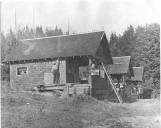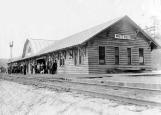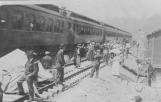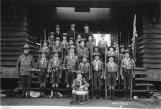1
In 1904, the Great Northern Railway began constructing a new railway line along the shore of Semiahmoo Bay near White Rock, British Columbia. The decision had been made to reroute the line from central Surrey in order to connect with a new railway bridge constructed across the Fraser River at New Westminster. The coastal route would be more direct, and avoid the steep grades further inland.3
A Great Northern train lets off a group of passengers at the original station.1909
White Rock, B.C., Canada

4
The Great Northern's coastal route took years of hard work to complete. Running from Blaine, Washington to New Westminster, B.C., the new line was completed in January 1909. On the morning of March 15, the first passenger train stopped at the new station in White Rock.5
Each summer more cottages and summer houses were built, replacing tents and shacks.1910
White Rock, B.C., Canada

6
The modest first station soon proved to be inadequate for the many needs of the growing community since White Rock was gaining popularity as a summer holiday spot. Cottages and summer homes began to spring up as the population increased during the boom years before the First World War.8
Because of White Rock's proximity to the border with the United States, Customs and Immigration facilities were required. An increasing number of freight, lumber and passenger trains to White Rock soon overwhelmed the humble station. It was logical to combine the functions of the train station with Customs and Immigration.10
On January 1, 1913 a more substantial train station opened in White Rock. It was unusually large for such a small town since it housed the railway offices, Customs and Immigration offices, and Immigration holding cells. The handsome building immediately became a focus of the community.11
A view of the east end of the station where the Immigration offices were housed.1915
White Rock, B.C., Canada

13
"The building was quite important to the community I would say. The Mayor would show up maybe once a month, and we had a lot of people that made it a practice to drop in on us in the evenings. It was a sort of a social aspect. I mean the station was White Rock's downtown. It was the only changing room for the whole White Rock beach. So the ladies' restroom, where you now have your museum gift shop office, was the busiest spot in town."-Brent Pravitz, Railway Station Clerk in the 1950s
14
"The station was looked upon as being a busy place though, what with taking people off who were crossing the border, hobos and that, on the railroad. The ones that were considered inadmissible and they were going to have them shipped back the next day, they were in the cells here, and one of our hobbies as kids was you'd come down here in the evening and talk to these hobos. They were characters. They could tell you about all the hobo jungles from here to San Francisco.Also the station was very important for telegraphs. People would run down and get one of the telegraph operators out of bed because their grandmother was dying or something or other."
-Don Munro, White Rock resident since 1921.



